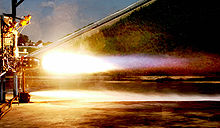Kestrel Rocket Engine Video - Engine firing
|
|
Kestrel
Kestrel 2

: Country of origin
: Manufacturer
: Application
: Liquid-fuelled engine
: Propellant
: Cycle
Performance:
: Thrust(Vac)
: Thrust-to-weight ratio
: Chamber pressure
: Isp(Vac)
Dimensions:
: Dry weight
: References
References:
:

Picture - Kestrel engine test firing.
The Kestrel engine is an LOX/RP-1 pressure-fed rocket engine. The Kestrel engine was developed by SpaceX for upper stage use on the Falcon 1 rocket.
Kestrel was built around the same pintle architecture as the Space X Merlin engine but does not have a turbo-pump and is fed only by tank pressure.
Kestrel is ablatively cooled in the chamber and throat and radiatively cooled in the nozzle, which is fabricated from a high strength niobium alloy. As a metal, niobium is highly resistant to cracking compared to carbon-carbon. According to SpaceX, an impact from orbital debris or during stage separation might dent the metal but have no meaningful effect on engine performance. Helium pressurant efficiency is substantially increased via a titanium heat exchanger on the ablative/niobium boundary.
Thrust vector control is provided by electro-mechanical actuators on the engine dome for pitch and yaw. Roll control (and attitude control during coast phases) is provided by helium cold gas thrusters.
A TEA-TEB pyrophoric system is used to provide multiple restart capability on the upper stage. In a multi-manifested mission, this allows for drop off at different altitudes and inclinations.
Kestrel 2
Enhancements to the design of the original Kestrel engine are planned. Changes will include tighter tolerances to improve consistency, higher Isp, and lighter weight.
Draco (rocket engine)
Merlin (rocket engine)
Kestrel Pictures
Living Warbirds: The best warbirds DVD series.
Source: WikiPedia